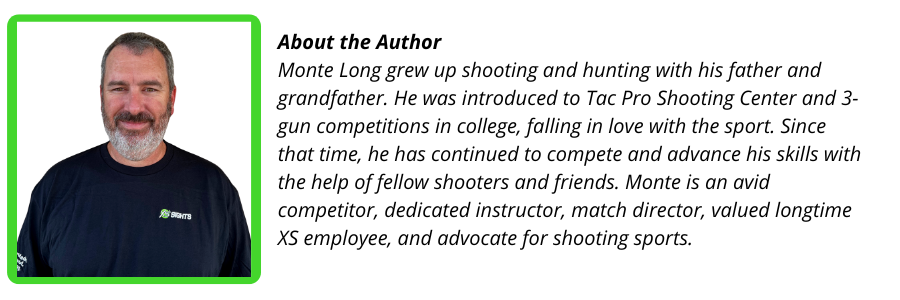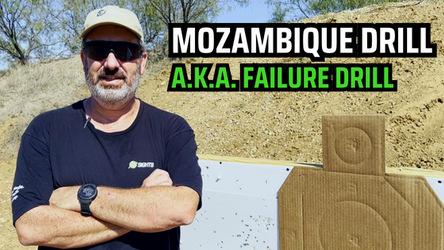Mozambique Drill a.k.a. Failure Drill
Posted by Monte Long on Mar 17th 2023
Alright, it's time to set your sights on another drill! Today, we're going to talk about one of the classic drills used by Jeff Cooper and his instructor cadre at Gunsite. Simply put, the Mozambique drill, or the Failure Drill as it is also known, is a quick, three round drill. The shooter fires two rounds to the body of an IPSC or IDPA target, then transitions to the head of the target and fires an additional round. Like I said, it's a quick, easy, low round count drill that works several skills.
Mozambique Drill: Why talk about it?
Why am I talking about a drill that's been around since before I was born? Let's diverge from the drill for just a moment and I'll tell you why. Recently, Bill Wilson and Ken Hackathorn, did an episode of their Gun Guys on the Wilson Combat YouTube channel called "Do not commit the 7 shooters sins." It is an excellent video and well worth the time to watch. Ken and Bill are both extremely accomplished and knowledgeable shooters and instructors, and their videos, on top of being entertaining, are very informative.
Most shooters are guilty of at least one of the sins mentioned. I'm talented. I've been guilty of more than one. However, the one I'm most guilty of, is not practicing what I suck at. Let's be honest. It’s way more fun to practice what you're good at. I mean, you're good at it. It makes you feel all warm and fuzzy when you practice the skill you're good at because you finish a drill and think “Damn! I shoot that GOOD!” So, what am I not so good at? Drawing from concealment, especially from an appendix inside the waist band holster.
Sure, I could practice one shot draws. That's quick and it's low round count. It is only one round, after all. But I know me. I will cheat on a one-shot draw. I can sacrifice grip and stance a little bit (there's another one of those sins that Bill and Ken talk about!) and still get a good hit on a one-shot draw. That doesn't work out so well if I've got to make two or three shots. So, I'm going to use the Mozambique to help me with that. As a bonus to working a concealed draw, I get to see what kind of split time and transition time I can get.
Why is it called the Mozambique Drill?
So, why's it called the Mozambique Drill? Colonel Cooper developed the drill after hearing about the experience of his friend, Mike Rousseau, when Rousseau was fighting guerrillas in Mozambique during the Mozambican civil war in the late 1960's. Rousseau was in a firefight at the airport in Lourenço Marques, which is known as Maputo now. Rousseau rounded a corner inside the airport and came face to face with a guerrilla carrying an AK. Both men attempted to shoot each other, but Rousseau was faster. He fired two rounds into the guerrilla's chest before he could bring the AK to bear on Rousseau. Unfortunately, the guerrilla did not immediately go down. Rousseau quickly analyzed the situation and fired an additional round at the guerrilla’s cranium. While the shot went low and hit the guerrilla in the throat, it did serve to drop the guerrilla and Rousseau lived to fight another day.
Cooper heard the story and thought that it would make a good drill. The Mozambique Drill was incorporated into the curriculum at Gunsite. From my understanding, it was initially taught as two rounds to the chest, the handgun was then lowered to the ready position as the shooter assessed the situation, and then the pistol was brought back on target and the final round was delivered to the cranial vault.
Larry Mudgett and John Helms, two of the officers and instructors from the LAPD S.W.A.T. team, were exposed to the drill when they attended Gunsite in the early 1980's. They quickly realized the value of the drill, and asked Cooper if they could take it back to the department and use it as an instructional tool. They were, however, concerned that it might be received negatively if they kept the Mozambique moniker and asked the Colonel if they could call it the Failure Drill. Cooper graciously allowed them to use the drill using whatever name they felt appropriate, as long as they would teach it to their officers. They did end up altering the drill just a little bit - rather than dropping the gun to a low ready, they began to teach the drill with the gun remaining on target to save precious time. The shooter would fire a pair to the body as quickly as possible, assess the target through the sights, then make the transition to the head and fire the final round.
The Mozambique Drill: How do you do it?
For this one, I shot the drill on an IDPA target because I had a couple available. I shot the drill at 7 yards, from a surrender (wrists above shoulders) position. I thought I had a copy of the USPSA classifier from the olden days of yore that mentioned that start position, but I can’t seem to find it. It could be that I was just remembering one of the most famous cinematic uses of the Mozambique – Jim Zubiena in “Calderone’s Return (Part 1)” from the first season of Miami Vice.
Unlike a lot of drills, I didn’t approach this one with a set par time. I wanted to establish a good baseline for what I am currently achieving. I shot the drill from a JM Custom Kydex AIWB holster with my Glock 19 fitted with DXT2 Yellow Big Dot sights and a CZ P10-C, also wearing a set of DXT2 Yellow Big Dot sights. After each run, I wrote down the total time, the time to the first shot (the draw), the split and the transition. Those three rounds gave me a bunch of information.
Looking at the data, I can see that my splits were all between .22 and .25 for both pistols. That’s about normal for me with the Glock 19 and the CZ. Occasionally, I’ll be a bit faster, but .25 is pretty normal for those two for me. With both guns, I was between .59 and .82 for the transition to the head. I should be faster on that, but that’s what I did when we filmed the videos. I’ve got the info, so I can track progress on it going forward.
The draw was what I was really wanting the info on. When we filmed the videos, I was consistently between 1.9 and 2.2 seconds, with my fast time being 1.75. I’d really like to get that to a consistent 1.25-1.5 second draw.
So, what do you do with that information?
First off, I’m going to spend some time watching the draw strokes that we’ve got on video. I really want to analyze that and see where I might have any wasted movement that I can work on getting rid of. Additionally, I’m really going to watch the third draw with the CZ, which was the worst one of the day, and see if I can figure out why I bobbled that draw. That 2.23 was pretty rough, and it got in my head and slowed me WWWAAAAYYY down on the transition.
Next, I’m going to work the draw in dry fire. I’ll start by working the draw dead slow while working on perfect mechanics. I want everything to be as close to perfectly correct as possible. Then, I’ll break out the timer and set a par time. The nice thing about the AMG Lab Commander timer is that you can set it sensitive enough to pick up a dry fire from a Glock 19. I’m also going to set a par time. Initially, I’ll start off with a 1.9 second par. When I’m consistently making the 1.9, I’ll start taking off a tenth of a second at a time until I’m under the 1.5 I’m looking for. Once I’m hitting 1.5 consistently in dry fire, I’ll try it again at the range and see what happens.
As always, it’s a work in progress, and I’m rarely happy with my performance. Once I get to 1.5 seconds on the draw, I’ll be telling myself that I need to get to 1.2 and the cycle will start all over again. Go out, give it a try, and let us know how you did!


